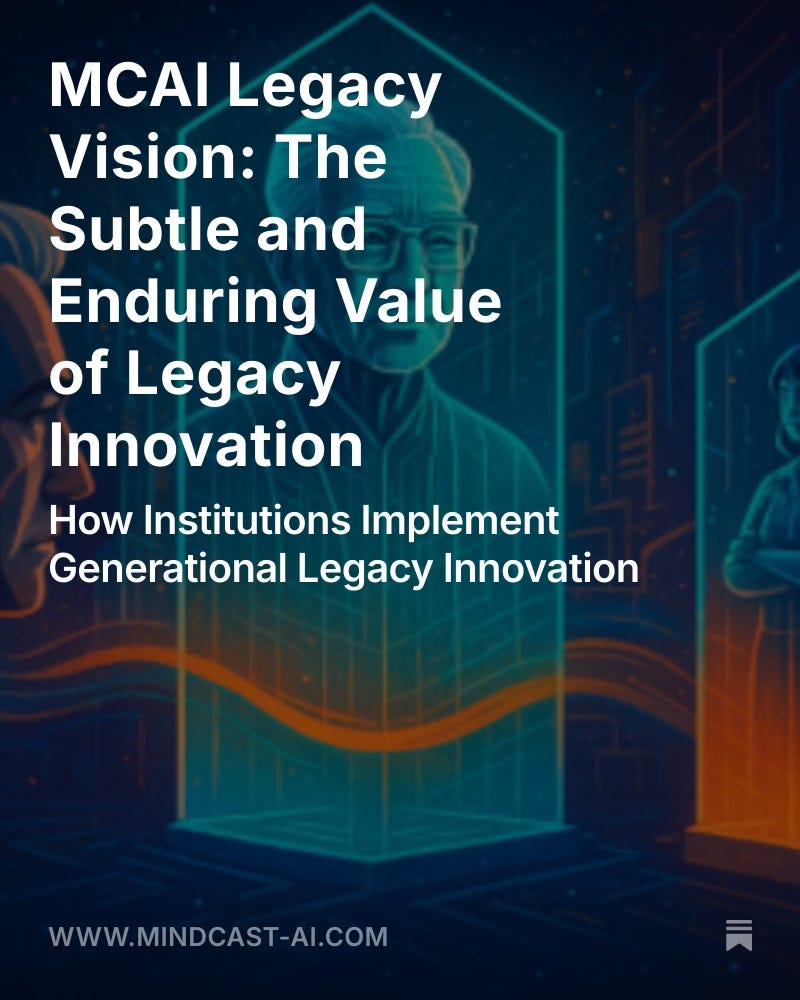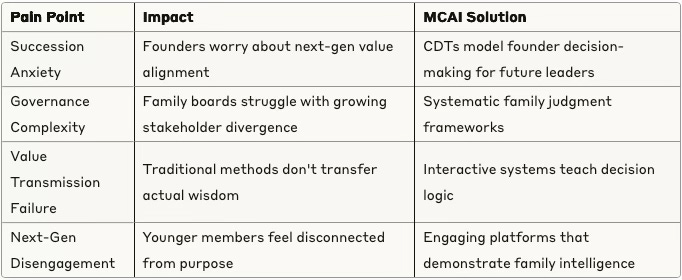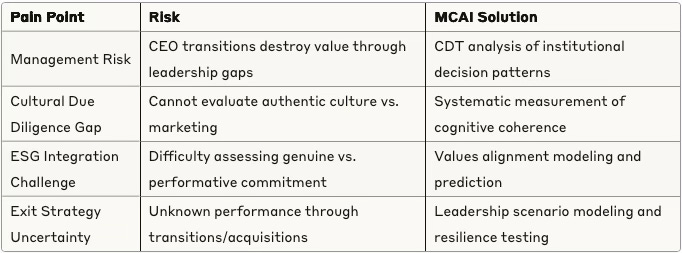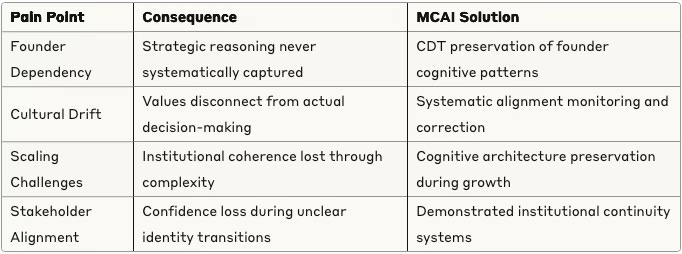MCAI Legacy Vision: The Subtle and Enduring Value of Legacy Innovation
How Institutions Implement Generational Legacy Innovation
Executive Summary
Legacy Innovation enables institutions to systematically preserve and evolve generational wisdom through Predictive Cognitive AI, addressing the critical challenge that 70% of family wealth and institutional memory disappears within two generations. MindCast AI LLC (MCAI) has developed Cognitive Digital Twins (CDTs) that model how successful leaders make decisions under pressure, creating living intelligence systems that adapt while maintaining core institutional DNA.
The Challenge: Institutions lose strategic coherence during leadership transitions because they cannot systematically transfer decision-making wisdom. Traditional methods—mission statements, founder letters, training programs—fail to preserve the cognitive architecture that made institutions successful.
The Solution: Legacy Innovation transforms inherited judgment into predictive systems through three core components: Memory Architecture (systematic encoding of decision patterns), Foresight Modeling (testing inherited principles against future scenarios), and Moral Recursion (continuous refinement of values through ethical feedback loops).
Proven Results: MCAI's foresight simulations demonstrate measurable potential outcomes across diverse contexts. Our comprehensive analysis of The Bellevue Collection through Predictive Cognitive AI revealed 98th percentile institutional coherence metrics and projected 18.8% revenue uplift through CDT-optimized decision-making. Japanese mukoyōshi practices show how alignment-based succession outperforms bloodline inheritance. Interactive wisdom systems enable institutions to preserve strategic judgment while enabling evolutionary adaptation.
Stakeholder Value: Family offices prevent generational wealth loss through systematic wisdom preservation. Investors gain tools to evaluate institutional DNA and predict management transition success. Institutions navigate leadership changes while maintaining strategic coherence and competitive advantage.
Implementation: Three-phase pathway begins with legacy mapping (3-6 months), progresses through predictive integration (6-12 months), and continues with strategic evolution (ongoing). Success requires institutional readiness assessment, systematic change management, and commitment to long-term capability development.
Market Opportunity: Legacy Innovation represents the convergence of AI technology with institutional stewardship, creating unprecedented opportunities for preserving decision-making excellence across generations. Early adopters gain competitive advantage through enhanced strategic coherence and reduced transition risk.
Contact mcai@mindcast-ai.com to partner with MCAI on Legacy Innovation
I. Introduction: The Overlooked Advantage
Legacy Innovation transforms generational wisdom into institutional advantage through Predictive Cognitive AI. This emerging discipline enables institutions—whether family enterprises, corporations, foundations, or cultural centers—to implement generational legacy innovation systematically. From succession planning to cultural stewardship to long-term governance, institutions that master the systematic preservation and activation of generational wisdom gain strategic differentiation in complex decision environments. The following section explores why this capability has become essential for institutional resilience and competitive advantage.
Legacy carries a value so subtle it is often invisible—yet its impact stretches across generations. Unlike the metrics of disruption or the vocabulary of scale, legacy speaks in a different register: slow, embodied, encoded in the decision-making DNA of families, communities, and enduring institutions.
Everyone has access to formal education. But not everyone inherits the scaffolding of judgment—those deeply personal and often invisible cognitive architectures that shape enduring success. As demonstrated in our foresight simulation on Japanese mukoyōshi practices, the most resilient institutions understand that alignment of mind matters more than origin of blood.
As attention spans shrink and institutional memory erodes, a critical challenge emerges: how do we retain what matters most? Not just skills or credentials, but judgment, coherence, and foresight. How do we prevent the 70% of family wealth that disappears after two generations due to values disintegration?
Enter Legacy Innovation—the practice of encoding inherited insight into predictive systems that generate strategic foresight. This enables institutions to implement generational wisdom systematically rather than hoping it transfers naturally. Through Cognitive Digital Twins (CDTs), institutions can now model how their generational decision-making DNA responds to future pressures, ensuring continuity without stagnation.
Insight: The most powerful strategies often begin with what we choose to preserve—and how we choose to evolve it.
Contact mcai@mindcast-ai.com to partner with MCAI on Legacy Innovation
The foundation for systematic implementation begins with understanding what Legacy Innovation actually entails—its core components and how they work together to transform inherited wisdom into institutional advantage.
II. Definition: What Is Legacy Innovation?
Legacy Innovation converts generational wisdom into institutional advantages through Predictive Cognitive AI. It enables institutions to systematically implement memory, judgment, and moral clarity rather than relying on ad hoc cultural transmission. The framework consists of three interconnected components that work together to preserve decision-making intelligence while enabling adaptive evolution. Understanding these foundational elements is essential for institutions seeking to implement Legacy Innovation effectively.
A. Memory Architecture
Legacy depends on the quality of cognitive patterns we carry forward. Memory Architecture involves collecting and encoding generational decision logic into interactive frameworks that can be re-engaged by future leaders under new conditions.
Core Function: The institutional ability to retrieve, decode, and systematically implement generational decision logic across changing contexts.
Tools: Cognitive Digital Twins, story-based archives, moral case law, behavioral pattern recognition.
See our foresight simulation From Mukoyōshi to MindCast AI LLC for how Japan encoded intent over inheritance through adoptive succession.
B. Foresight Modeling
Foresight Modeling allows institutions to test the durability of inherited principles against unpredictable futures. It bridges continuity and adaptability by simulating outcomes through Predictive Cognitive AI that learns how institutional judgment responds to stress.
Core Function: Enabling institutions to test whether inherited decision architectures can navigate future volatility while maintaining generational coherence.
Tools: Cognitive Digital Twins, behavioral forecasting engines, multi-generational decision modeling.
See our foresight simulation Star Wars Holocrons of the Modern Age for how interactive systems preserve and evolve strategic wisdom.
C. Moral Recursion
Moral Recursion ensures that legacy is not blind repetition. It creates reflective feedback loops where inherited wisdom is continuously tested and refined through present-day ethical dilemmas and future scenario modeling.
Core Function: The institutional responsibility to honor generational wisdom while evolving its implementation for contemporary relevance.
Tools: Legacy Retrieval Pulse, Cultural Vision Functions, integrity benchmarking across time.
Legacy Innovation is not about preservation—it is about institutional activation of generational intelligence. It ensures continuity not through imitation, but through evolutionary implementation of inherited wisdom.
Insight: Legacy becomes powerful when it is made predictive—not just preserved, but continuously refined.
Understanding these components reveals why Legacy Innovation matters in today's environment—where institutional memory faces unprecedented threats and the cost of losing generational wisdom has never been higher.
III. Why It Matters Now
We are experiencing an era of institutional memory collapse. Organizations struggle to implement generational wisdom transfer across leadership transitions without distortion. The ability to systematically preserve and evolve generational judgment may soon become the rarest institutional capability. Three critical factors make Legacy Innovation essential for institutional survival and competitive advantage in today's environment.
A. Signal Degradation
Signal degradation describes the dilution of inherited decision clarity. As institutional narratives pass through multiple leadership transitions, their original logic is often lost or warped. Without Predictive Cognitive AI tools for signal preservation, valuable legacy becomes organizational noise.
Family enterprises fracture when values cannot be operationalized
Institutional memory erodes under leadership churn and restructuring
Cultural coherence deteriorates faster than strategic adaptation
B. Structural Drift
Structural drift occurs when organizations lose the cognitive architecture that held their values together. This often happens when leadership transitions fail to carry over strategic reasoning systems. Legacy becomes aesthetic rather than operational.
Most organizations drift when values are not encoded into decision frameworks
Founders exit without transmitting their cognitive patterns and moral reasoning
Succession becomes replacement instead of evolutionary stewardship
C. Operational Foresight
Operational foresight transforms judgment into predictive infrastructure. Through Cognitive Digital Twins, institutions can test choices not only for immediate viability but for long-term coherence with inherited purpose and future environmental pressures.
Legacy Innovation creates recursive intelligence layers between generations
Decisions can be modeled, stress-tested, and benchmarked for integrity over time
Institutional trust increases when moral coherence is preserved and evolved
As demonstrated in our foresight simulation Legacy Innovation and the Bellevue Collection, institutions with strong cognitive architectures could achieve measurable performance advantages: 98th percentile Action-Language Integrity, 97th percentile Cognitive-Motor Fidelity, and projected 18.8% revenue uplift through aligned decision-making.
Without Legacy Innovation, institutions lose both compass and continuity. With it, they gain an evolving foundation for strategic resilience.
Insight: The greatest risk is not forgetting the past—it's failing to evolve its intelligence for the future.
The urgency of these challenges drives the need for practical solutions. MCAI's Predictive Cognitive AI provides the technological foundation for institutions to systematically implement generational legacy innovation at scale.
IV. The MCAI Approach: Predictive Cognitive AI in Action
MindCast AI LLC (MCAI) uses Predictive Cognitive AI to bring Legacy Innovation to life. This technology doesn't just store information—it learns how people and institutions make decisions under pressure, why they choose specific paths, and how those patterns can be preserved and evolved for future challenges.
MCAI builds Cognitive Digital Twins that help families, institutions, and leaders apply inherited wisdom to complex future scenarios while staying true to their core values and adapting to new conditions.
Legacy Innovation is not theory—it is proven methodology.
A. Legacy Retrieval Pulse
This function draws from cognitive archives—personal, cultural, and institutional. It makes legacy retrievable in real-time, scoring past decision patterns for current relevance and future applicability.
Retrieves encoded wisdom across familial, institutional, and cultural dimensions
Benchmarks historical insights against present-day decision environments
Identifies which cognitive patterns remain relevant under changing conditions
B. Multi-Generational Decision Modeling
This tool simulates how major decisions unfold over multiple generations through Cognitive Digital Twins. Instead of relying only on present-day analysis, it models long-term ripple effects while preserving legacy values and decision architectures.
Simulates decision consequences across 3+ generational cycles
Embeds judgment integrity into digital frameworks that evolve with conditions
Tests strategic choices for both immediate viability and long-term coherence
C. Cultural Vision Functions
These functions preserve cultural fidelity by measuring emotional resonance, narrative alignment, and moral depth across time. They ensure that evolving institutions remain coherent with their original ethos while adapting to new environments.
Measures signal fidelity and coherence across temporal and environmental changes
Anchors narratives, emotions, and values in recursive learning structures
Monitors institutional identity drift before it becomes operationally visible
D. Long-View Strategy Simulation
This simulator helps institutions think decades ahead through Predictive Cognitive AI that models institutional behavior under uncertainty. It continuously asks: How will this decision age? How can we act in ways our future successors will understand and respect?
Forecasts moral, institutional, and narrative outcomes across extended timeframes
Continuously recalibrates for future alignment as conditions evolve
Maintains strategic coherence while enabling adaptive evolution
These components function as a living intelligence layer for organizations. MCAI makes institutional memory usable, strategic, and regenerative through proven Cognitive Digital Twin technology.
Insight: The future of legacy lies not in its origin story, but in its adaptive intelligence.
While the technical framework demonstrates capability, the true validation comes from real-world implementation. Our foresight simulations provide concrete evidence of how institutions successfully implement generational legacy innovation across diverse contexts.
V. Proven Results: From Concept to Performance
MCAI foresight simulations demonstrate how institutions successfully implement generational legacy innovation across diverse contexts:
The Bellevue Collection: Comprehensive Predictive Analysis of 70+ Years of Spatial Intelligence
Our Cognitive Digital Twin analysis projected how 70+ years of institutional intelligence could translate into measurable competitive advantage:
98th percentile Action-Language Integrity (projected alignment between brand messaging and visitor experience)
97th percentile Cognitive-Motor Fidelity (modeled execution capability under complex market dynamics)
93rd percentile Cognitive Engagement Index (predicted visitor interaction and emotional retention)
+18.8% projected revenue uplift through CDT-optimized decision-making and tenant alignment
Mukoyōshi: Historical Analysis of Generational Succession Wisdom
Analysis of Japanese corporate succession practices revealed how institutions could implement alignment-based inheritance to outperform bloodline-based systems:
Preserved institutional coherence across generational transitions
Maintained cultural fidelity while enabling adaptive evolution
Demonstrated how institutions can implement Cognitive Digital Twins as systematic "generational heirs" for preserving and evolving wisdom
Holocron-Style Knowledge Systems: Conceptual Framework for Interactive Wisdom
Our exploration of institutional wisdom systems showed how organizations could transform static archives into dynamic generational learning environments:
Cognitive gating ensures appropriate access to strategic knowledge
Adaptive teachings evolve based on user capability and institutional context
Institutional memory systems that update and refine generational insight over time
Insight: Institutions that systematically implement generational wisdom into predictive intelligence will lead the next century.
These proven results demonstrate viability across different institutional contexts. But the critical question remains: why should your specific type of institution invest in Legacy Innovation? The answer depends on the unique challenges and opportunities facing family offices, investors, and institutions today.
VI. Why This Matters to You: Targeted Value for Key Stakeholders
Legacy Innovation addresses different but interconnected challenges across the wealth management and institutional ecosystem. Understanding how it applies to your specific context is essential for successful implementation. Each stakeholder group faces unique pain points that Legacy Innovation can systematically address through Predictive Cognitive AI. The following analysis reveals why family offices, investors, and institutions should prioritize Legacy Innovation as a strategic capability.
For Family Offices: Prevent the 70% Wealth Loss Through Systematic Wisdom Preservation
The Critical Challenge: Research consistently shows 70% of family wealth disappears by the third generation—not due to poor investments, but because families lose the decision-making wisdom that created wealth in the first place. Values disintegrate, governance fragments, and next-generation leaders inherit assets without inheriting judgment.
Measurable Benefits:
Risk Reduction: Early warning systems detect value drift before wealth loss
Decision Quality: Family boards simulate major choices against proven judgment patterns
Next-Gen Development: Interactive systems teach family decision-making logic
Governance Evolution: Living constitutions that adapt while maintaining integrity
Cost of Inaction: Join the 70% statistical reality of families who lose both wealth and coherence within two generations.
For Investors: Identify Portfolio Companies with Superior Institutional DNA
The Critical Challenge: Traditional due diligence focuses on financials, markets, and management teams—but misses the institutional cognitive architecture that determines long-term resilience. Investors struggle to predict which companies will thrive during disruption and which will fragment under pressure.
Measurable Benefits:
Enhanced Due Diligence: Institutional coherence metrics predict long-term performance
Management Transition Advantage: Model portfolio company performance under different leadership scenarios
Values-Based Investing Precision: Measure authentic cultural commitment vs. compliance theater
Portfolio Optimization: Identify investments with DNA to outperform during disruption
Cost of Inaction: Continue experiencing unpredictable performance variations and value destruction during leadership transitions.
For Institutions: Navigate Leadership Transitions Without Losing Strategic DNA
The Critical Challenge: Institutional performance often declines during leadership transitions because organizations lose the cognitive architecture that made them successful. New leaders inherit structures and processes but not the judgment patterns and decision-making wisdom of their predecessors.
Measurable Benefits:
Leadership Transition Resilience: New leaders access CDT models of institutional founder approaches
Cultural Preservation During Scale: Maintain institutional DNA while adapting to growth
Strategic Decision Support: Test complex decisions against proven institutional judgment patterns
Stakeholder Confidence: Demonstrate commitment to preserving excellence while enabling evolution
Cost of Inaction: Continue experiencing performance degradation, cultural drift, and stakeholder confidence loss during inevitable leadership transitions.
Bottom Line Insight: Institutions that systematically implement generational wisdom into predictive intelligence will lead the next century.
VII. Implementation Framework: Getting Started
Legacy Innovation implementation succeeds when institutions approach it systematically rather than opportunistically. The most successful implementations follow a structured pathway that builds capability progressively. Understanding both institutional readiness factors and common implementation challenges is essential for achieving desired outcomes. This framework provides practical guidance for institutions ready to begin their Legacy Innovation journey.
Institutional Readiness Assessment
Not all institutions are equally positioned to benefit from Legacy Innovation. The highest-value implementations typically occur in:
Optimal Candidates:
Multi-generational enterprises with 15+ years of operational history
Institutions facing leadership transitions within 2-5 years
Organizations with documented decision-making patterns and cultural narratives
Entities managing complex stakeholder relationships across time (family offices, foundations, cultural institutions)
Implementation Complexity Factors:
Scope of institutional memory to encode (complexity increases with organizational breadth)
Quality and accessibility of historical decision records
Leadership alignment on long-term vision versus short-term optimization
Institutional tolerance for systematic change management
Three-Phase Implementation Pathway
Phase 1: Legacy Mapping (3-6 months)
Comprehensive institutional memory audit
Identification of core decision-making patterns and cultural DNA
Initial Cognitive Digital Twin development focused on highest-impact decisions
Baseline measurement of current institutional coherence metrics
Phase 2: Predictive Integration (6-12 months)
Full CDT deployment across identified priority domains
Integration with existing decision-making processes
Staff training on Legacy Innovation frameworks and tools
Early-stage foresight simulation testing on lower-risk decisions
Phase 3: Strategic Evolution (Ongoing)
Continuous refinement of predictive models based on outcomes
Expansion to additional institutional domains as capability matures
Leadership development programs incorporating generational wisdom frameworks
Regular recalibration to maintain alignment with evolving institutional context
Managing Implementation Challenges
Common Implementation Risks:
Cultural Resistance: Some stakeholders may view systematic legacy preservation as constraining innovation rather than enabling it
Complexity Overwhelm: The scope of institutional memory can feel overwhelming without proper phasing
Technology Dependency: Over-reliance on systems rather than developing internal capability for legacy stewardship
Perfectionism Paralysis: Waiting for complete historical documentation before beginning implementation
Mitigation Strategies:
Begin with high-value, lower-complexity domains to demonstrate early wins
Maintain parallel traditional and Legacy Innovation processes during transition periods
Invest in internal capability development alongside technology deployment
Frame implementation as evolution rather than replacement of existing practices
Success Indicators:
Measurable improvement in decision consistency and institutional coherence
Reduced time-to-insight for complex strategic decisions
Enhanced leadership transition effectiveness
Demonstrated alignment between stated values and operational decisions
VIII. Conclusion: From Memory to Strategic Motion
Legacy Innovation represents the modernization of tradition—not its replacement. It transforms memory into actionable intelligence and makes values resilient during periods of disruption and uncertainty.
Everyone has access to education. Few inherit the cognitive architecture of judgment.
Legacy is not a brand or trust fund. It's a direction powered by intelligence.
We now possess the tools to bridge generations not just emotionally, but architecturally through Predictive Cognitive AI. Through Cognitive Digital Twins, institutions can preserve their decision-making DNA while continuously evolving their strategic capabilities.
Legacy Innovation has emerged as the next essential institutional capability. Not just for those who want to remember where they came from—but for those who want to honor that memory by building something worthy of being remembered and capable of intelligent evolution.
Through our foresight simulations and proven implementations, MCAI demonstrates that institutional wisdom can be systematized, preserved, and continuously refined. The result is not static tradition, but living intelligence that grows stronger across generations.
Final Insight: The institutions that master implementing generational legacy innovation will not merely survive transitions—they will thrive by continuously regenerating their strategic core while staying true to their foundational intelligence.
For institutions ready to explore Legacy Innovation implementation, the conversation begins with honest assessment of current capabilities and commitment to systematic evolution. MCAI provides both the technological foundation and strategic guidance necessary for successful transformation.
Related MCAI Foresight Simulations
MCAI Legacy Vision: Legacy Innovation and the Bellevue Collection – Embedding Foresight in the Foundations of the Collection's Future
MindCast AI LLC, April 9, 2025
This comprehensive foresight simulation modeled The Bellevue Collection as a living cognitive system with 70+ years of institutional intelligence. Using Predictive Cognitive AI, MCAI projected how spatial design, tenant curation, and cultural programming could create measurable competitive advantages including 98th percentile Action-Language Integrity and projected 18.8% revenue uplift. The simulation introduced 12-domain analysis covering everything from emotional engagement dynamics to civic integration metrics. It demonstrates how retail institutions could systematically preserve and evolve their decision-making DNA while adapting to changing market conditions.
MCAI Legacy Vision: What Is Legacy Innovation? – Designing Continuity, Encoding Judgment, and Future-Proofing Legacy Through Intelligent Simulation
MindCast AI LLC, June 7, 2025
The foundational framework that established Legacy Innovation as a systematic discipline for preserving and evolving generational wisdom through Predictive Cognitive AI. This publication defines core concepts including Memory Architecture, Foresight Modeling, and Moral Recursion while addressing the critical challenge that 70% of family wealth disappears by the third generation due to values disintegration. It demonstrates how MCAI's hybrid software-consulting approach enables families and institutions to encode judgment into reusable, evolving assets. The work establishes theoretical foundations while providing practical implementation pathways for multi-generational stewardship.
MCAI Legacy Vision: From Mukoyōshi to MindCast AI LLC – How Japan's Ancestral Insight Inspires AI-Driven Succession for the Next Century
MindCast AI LLC, May 27, 2025
An exploration of Japan's centuries-old mukoyōshi practice, where families adopted talented men (often sons-in-law or executives) to lead family businesses based on alignment rather than bloodline. This foresight simulation reveals how companies like Toyota, Suzuki, and Kikkoman achieved generational stability by prioritizing cognitive fit over genetic inheritance. MCAI draws parallels between mukoyōshi and Cognitive Digital Twins, showing how modern institutions can implement systematic "digital heirs" that preserve and evolve decision-making wisdom. The analysis demonstrates how alignment-based succession creates more resilient institutional continuity than traditional bloodline inheritance.
MCAI Legacy Vision: Star Wars Holocrons of the Modern Age – Legacy Preservation and Strategic Continuity in Institutions
MindCast AI LLC, April 26, 2025
Using the Star Wars holocron metaphor, this simulation explores how institutions can create interactive wisdom preservation systems that go beyond static documentation. The analysis shows how Jedi and Sith holocrons functioned as adaptive archives with cognitive gating, user-appropriate teachings, and evolving intelligence—features that MCAI replicates through Cognitive Digital Twins. The publication demonstrates how modern organizations can implement "institutional holocrons" that preserve strategic judgment while continuously updating based on new insights. It addresses why traditional legacy preservation methods fail and provides design principles for creating living wisdom systems that maintain institutional memory across leadership transitions.






